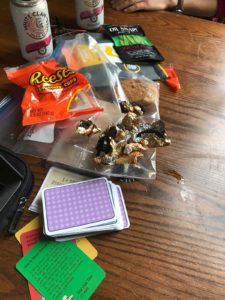Fueling Frenzy is a specialized card deck designed for use in a suite of games related to meal planning and nutrition on campus. After hearing about some of the politics around meal plans and food insecurity for undergraduates on campus, we started to think about how reliant students might be on free food and how much of that free food isn’t particularly healthy. Based on a combination of the USDA nutritional database, campus free food listservs, and campus dining hall menus, we identified a set of foods commonly found on campus (both for free and at dining halls), and assessed their healthiness based on different metrics. We found that many of the most frequently available foods on campus are not particularly healthy, which made us want to encourage healthy eating and thoughtfulness around meals through a set of games. One is a game of chance meant to simulate unthoughtful eating habits and one is a strategy game meant to encourage a more thoughtful approach to nutrition on campus.
Our game is meant as an orientation activity for incoming college freshmen (“prefrosh” at MIT). In general, these are young people who previously lived at home where their eating habits were externally determined and who rarely prepared their own meals. They have fast metabolisms, but only about a quarter of them will join sports teams. When combined, these factors suggest that the average freshman at MIT has probably not given much thought to his or her eating habits and might not see a need to do so. Prefrosh are also probably unprepared for the diversity of foods available on campus, and the sheer volume of free foods especially. As such, we want to intervene at the first possible moment–during orientation–to encourage healthy eating habits, play out MIT scenarios that might affect one’s nutrition, and ultimately make the connection between eating healthy foods and high cognitive functioning.
Because of finals-related constraints, we were not able to pilot with college freshmen. Instead, we ran two pilot games with former and future orientation leaders in MIT’s School of Architecture and Planning. This audience is useful to work out the kinks of facilitation, and were also all college freshman at one point in time. After each pilot, we conducted focus groups with the players to assess strengths and weaknesses of the games (this was in addition to the semi-structured conversations that happened at the mid- and end-points of each game).
Questions included:
- How clear were the game’s goals?
- How well did you think the importance of healthy eating was conveyed to students? How would you sharpen this message?
- How helpful did you find the mid and end facilitated discussions? Were there directions you’d like to take these conversations that weren’t explored this time?
- To what extent did you think the design of the game aided in its purpose? DId you think the “takeaway card” would be appealing/useful to your students?
- How empathetic do you think the game was, in terms of meeting students where they’re at as prefrosh and orienting them towards MIT dining? Are there potential areas of stigma that we should be aware of?

Feedback was largely positive. Players universally agreed that the game was “actually fun” and that the data associated with the cards yielded some surprising insights. For example, one player exclaimed “I always thought dumplings were a meal in themselves! …seeing them categorized as a starch, and not even that healthy of one… that will stick with me.” In terms of our logic model, the realizations about the relative nutrition of common foods available at MIT achieved the goal of providing helpful heuristics for judging the nutritional qualities of familiar foods. Players also agreed that the need in both games to recognize “balanced meals” was a good exercise; one player remarked that “the idea of pairing free foods with healthy ones should be obvious, except it’s really not!” Comments like this suggest that the goal of encouraging the enhancement of free foods with healthy additions, while recognizing that free food is enticing, was met through the second game.
The conversations were well received, especially for the first game that is meant to be played at a faster pace. A player in the second pilot explained “the discussions really helped to reframe the game– I tend to get caught up with winning, so the prompts were a necessary redirection.” Most of the constructive feedback concerned design and game logistics. For example, players found the different colors of the suits to be helpful, but thought that junk food should have been a “junky” color “like neon or black” to really distinguish their lack of utility as compared to the other suits. Another helpful suggestion was directed at the “takeaway” cards, that serve as a takeaway recipe card for game participants. While the aesthetics of these cards was appreciated, players raised the helpful point that the recipes should be pitched to what freshman can reasonably make in a dorm kitchen; instead of “how to cook fish,” toaster oven and microwave recipes would be more immediately useful to the audience.
The spreadsheet with our logic model with our short-term goals, and questions for freshman and orientation leaders can be found here.